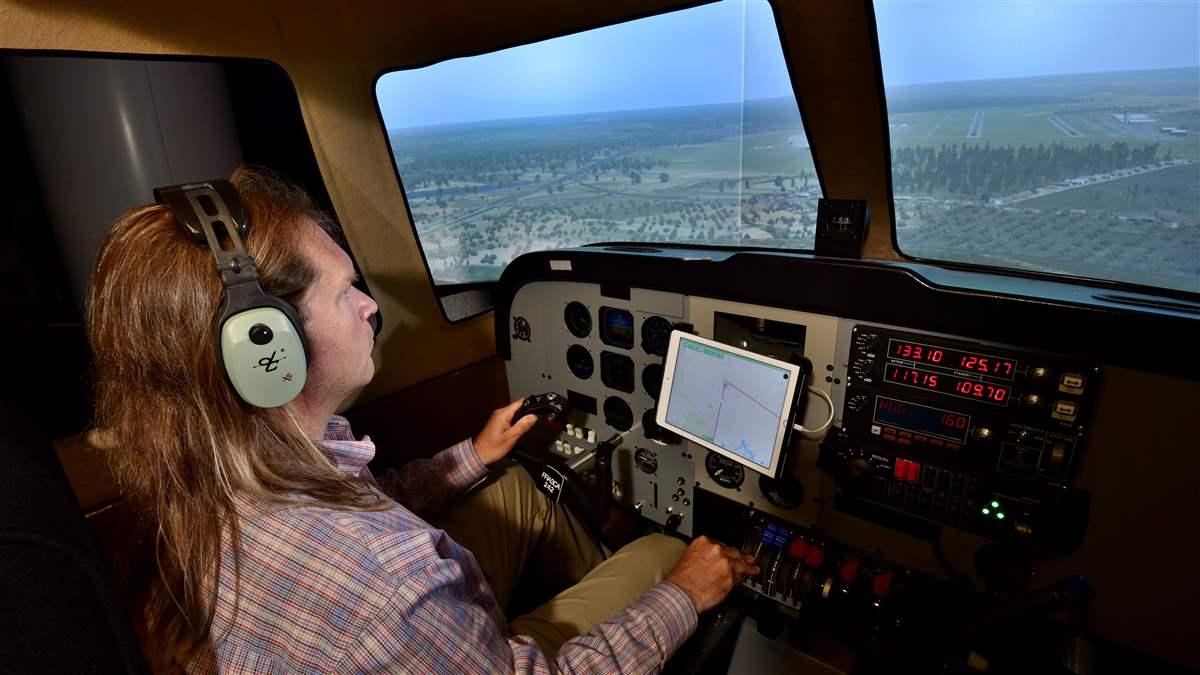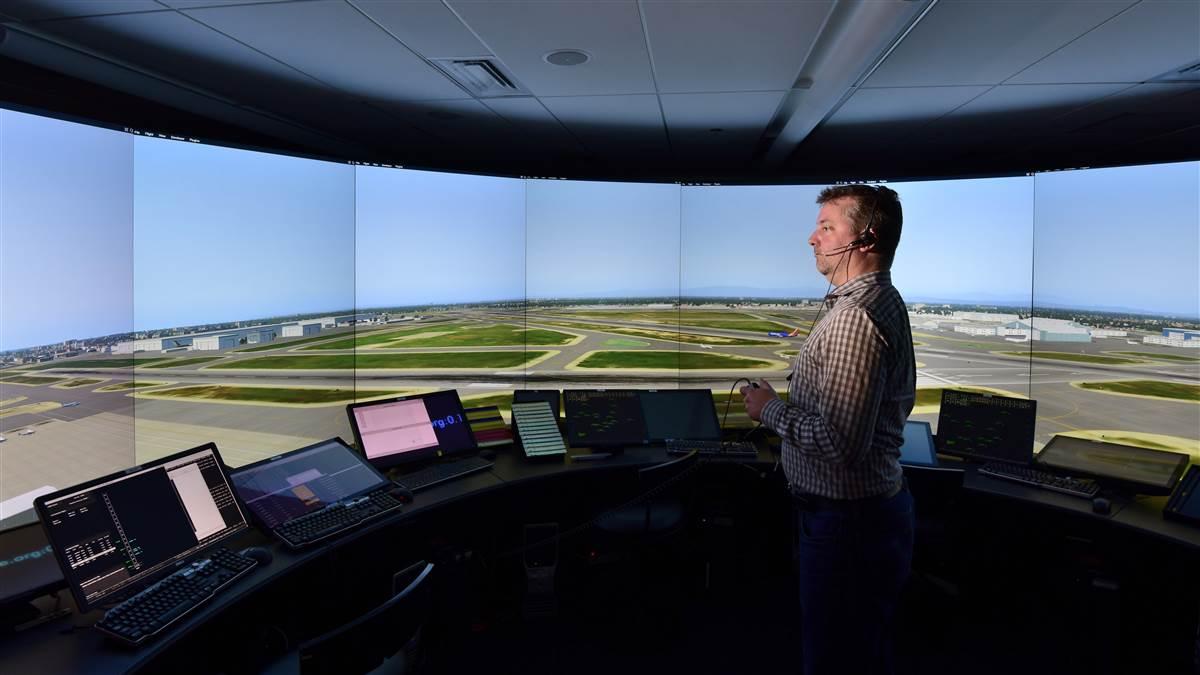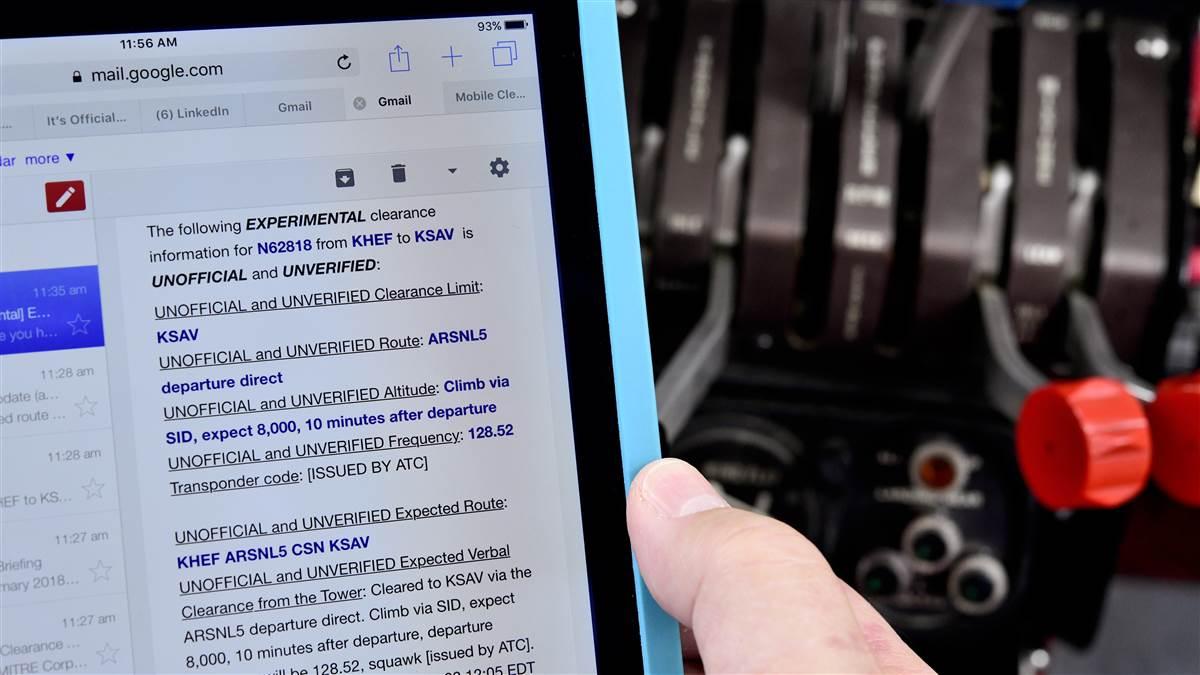Big idea: Inventing Tech
This lab is developing GA’s future

This isn’t a commercially available app, however. Pollack, co-head of MITRE’s Aviation Human-Centered Experimentation and Training Department, leads a team that has been working since 2015 on a project it calls Digital Co-Pilot. MITRE is a not-for-profit organization that conducts research for the FAA and other government agencies, and it has contributed heavily to new aviation technology.
Digital Co-Pilot’s objective is to provide pilots with information they need, when they need it, in a format that is not distracting—and to infer what the pilot wants to do. The concept includes speech recognition, which allows the pilot to ask for information, like an aeronautical Siri or Alexa. Pollack wanted to begin the Digital Co-Pilot research five years ago, but it wasn’t funded at the time. “It probably was a blessing in disguise,” he says, because some underlying technology didn’t exist and others, such as voice recognition, were nowhere near as good as they are today.
Taxiing onto a runway at Manassas (Virginia) Regional Airport, Pollack begins the takeoff roll. “Digital Co-Pilot knows we’re on the runway. It will give distance-remaining callouts.” It also offers an advisory that local weather conditions are deteriorating, and confirms that the altimeter is properly set.
“Conditions at Manassas now IFR,” the virtual voice intones. A compact audio interface connects Pollack’s iPad to the audio panel, allowing him to hear the Digital Co-Pilot’s aural alerts—and Digital Co-Pilot to hear and recognize his voice instructions.
“If you can get ahead of the airplane—and get ahead of the pilot—you can break that accident chain,” says Pollack, an active GA pilot who owns a Piper Aztec and is especially interested in weather. It’s hard to look at 30 METAR reporting stations and see how they’re changing over time, but software can do that quickly, he said. The goal is to assist the pilot by providing appropriate information—not to tell the pilot what to do, he added.
As his flight progresses, the software offers the automatic terminal information service radio frequency at an appropriate distance from the destination airport, and then the tower frequency. “It’s always trying to stay one step ahead. Ten steps ahead is too far,” Pollack said. “Most of these alerts will go away when the condition no longer warrants them.” Or the pilot can swipe them away.
Closer to the destination, a GUMPS—gas, undercarriage, mixture, props, seat belts—reminder is provided on short final, after the gear normally would be extended. It serves as a final reminder to keep a pilot from landing with the gear up, he said.
Notam processing is another objective. The 50-mile-wide corridor for a flight from Manassas to Louisville, Kentucky, generated 34 pages of notams—of which only 12 notams were truly relevant to the flight. The team is also working on taxi conformance monitoring, to reduce runway incursions.
Digital Co-Pilot resulted from a General Aviation Joint Steering Committee challenge—the public/private partnership uses a data-driven, consensus-based approach to improve GA safety—to address such single-pilot operational challenges as high workload, information overload, and loss of situational awareness. By combining aircraft, weather, traffic, procedure, and terrain data, Digital Co-Pilot infers the pilot’s intent and then seeks to intuitively provide strategic assistance. It currently offers 40 independent features, from checklist reminders, frequency information, and runway remaining to weather changes, final leg overshoot warnings, and approaches not to the destination airport. “Automatic checklists are a neat idea we’re working with. They could help with gear-up landings, or takeoffs with locked controls,” he said.
Although incredibly capable, Digital Co-Pilot isn’t much to look at. “The concept of Digital Co-Pilot is not for us to release an application,” Pollack explained, pointing out its rudimentary graphics. “Our map display is so basic because that’s quick and easy.” A commercial developer would integrate MITRE technologies into its existing moving map. And even though Digital Co-Pilot is still being developed, some resulting technology already has been transferred to industry through nonexclusive licenses.
 Much of the Digital Co-Pilot development is being conducted in MITRE Corp.’s Integration Demonstration and Experimentation for Aeronautics Laboratory (IDEA Lab). The facility was developed more than 25 years ago by MITRE’s Center for Advanced Aviation System Development (CAASD). Located on the fourth floor of an unassuming office building in McLean, Virginia, almost within shouting distance of a large suburban Washington, D.C., shopping mall, the lab has contributed to new technology in the cockpit, as well as to new air traffic control procedures and technologies, that help to make flying safer and easier. Significant new technologies, procedures, or operating practices relating to Automatic Dependent Surveillance-Broadcast In, wake turbulence avoidance, optimized metroplex airspace, and enhanced airport surface operations—among many others—were were conceived, developed, and/or validated here (see “IDEA Lab Graduates,” p. 76).
Much of the Digital Co-Pilot development is being conducted in MITRE Corp.’s Integration Demonstration and Experimentation for Aeronautics Laboratory (IDEA Lab). The facility was developed more than 25 years ago by MITRE’s Center for Advanced Aviation System Development (CAASD). Located on the fourth floor of an unassuming office building in McLean, Virginia, almost within shouting distance of a large suburban Washington, D.C., shopping mall, the lab has contributed to new technology in the cockpit, as well as to new air traffic control procedures and technologies, that help to make flying safer and easier. Significant new technologies, procedures, or operating practices relating to Automatic Dependent Surveillance-Broadcast In, wake turbulence avoidance, optimized metroplex airspace, and enhanced airport surface operations—among many others—were were conceived, developed, and/or validated here (see “IDEA Lab Graduates,” p. 76).
The IDEA Lab can combine two Transport category cockpit simulators, an advanced general aviation cockpit, and a simulated air traffic control facility—or the simulators can be used separately. Working with the FAA and others, the lab has worked on runway safety initiatives, airspace redesigns, air traffic controller training and procedural development, and even the optimal siting of new runways.
Tyson Weihs, ForeFlight co-founder and CEO, said the company has licensed MITRE technology, and he’s been impressed by some of MITRE’s accomplishments. “One of the most impactful things I think they’ve done is ADS-B,” he said. “The combination of the tablet and ADS-B is transformative. They were instrumental in the design of that.”
Not any organization can take a project that complex from the whiteboard to the operating environment, Weihs added. “When they wrap their heads around big-scale projects, the results are demonstrable. Only an insider who really understands the system is capable of doing that. I can’t imagine it coming into reality in any other way.”
He’s impressed by MITRE’s mobile IFR clearance delivery concept (see “Pilots Help Test IFR Clearances On Mobile Devices,” p. 77), which ForeFlight has helped to test. “It seems like a huge step forward. By helping to support the demo, we can expose a lot of customers to [the technology],” Weihs said. “I think the work [MITRE] has done has impacted us in ways we don’t fully realize.”
Any of the Digital Co-Pilot technologies, and those to come, can be licensed by an avionics manufacturer or software developer. “In the near future, I think we’ll have more and more of these features show up in these offerings,” Pollack said. When that happens, it’s usually through a confidential licensing agreement and not publicized. But if a feature like one of these shows up some day on your favorite EFB, know there’s a good chance it was initially conceived and validated by Pollack and his team in MITRE’s IDEA Lab.
Email [email protected]





